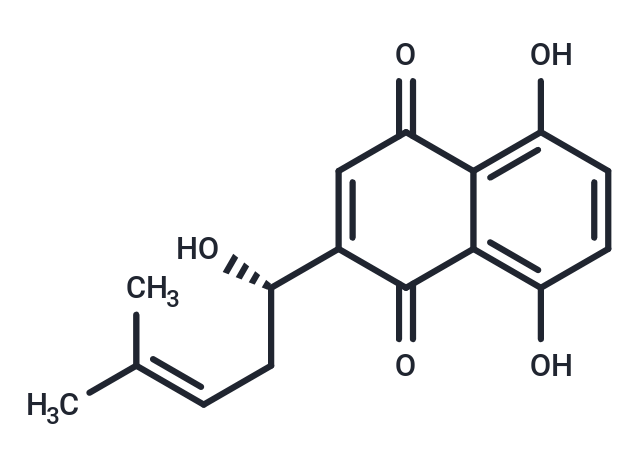Shopping Cart
- Remove All
 Your shopping cart is currently empty
Your shopping cart is currently empty

(-)-Alkannin (Shikonin) is a natural red naphthoquinone pigment, has antimicrobial, anti-tumor, and anti-inflammatory effects; a purified shikonin preparation is widely used for the production of medicinals, cosmetics, and some food products; shikonin also enters into the antiinflammatory ointment and cream compositions used for the treatment of burns. It can suppress the cell viability, adhesion, invasion and migratory ability of MGC-803 cells through TLR2- or NF-κB-mediated pathway.

| Pack Size | Price | Availability | Quantity |
|---|---|---|---|
| 20 mg | $60 | In Stock | |
| 1 mL x 10 mM (in DMSO) | $50 | In Stock |
| Description | (-)-Alkannin (Shikonin) is a natural red naphthoquinone pigment, has antimicrobial, anti-tumor, and anti-inflammatory effects; a purified shikonin preparation is widely used for the production of medicinals, cosmetics, and some food products; shikonin also enters into the antiinflammatory ointment and cream compositions used for the treatment of burns. It can suppress the cell viability, adhesion, invasion and migratory ability of MGC-803 cells through TLR2- or NF-κB-mediated pathway. |
| In vitro | 3-(4,5-Dimethylthiazol-2-yl)-2,5-diphenyltetrazolium bromide assay was performed for cell viability and adhesion ability of MGC-803 cells. Cell scratch repair experiments were conducted for the determination of migration ability while transwell assay for cell invasion ability. Western blot analysis and real-time polymerase chain reaction assay were used for the detection of protein and mRNA expressions. Fifty per cent inhibitory concentration of Shikonin on MGC-803 cells was 1.854?μm. Shikonin (1?μm) inhibited significantly the adhesion, invasion and migratory ability of MGC-803 cells. Interestingly, Shikonin in the presence or absence of anti-Toll-like receptor 2 (TLR2) antibody (2?μg) and nuclear factor-kappa B (NF-κB) inhibitor MG-132 (10?μm) could decrease these ability of MGC-803 cells markedly, as well as the expression levels of matrix metalloproteinases (MMP)-2, MMP-7, TLR2 and p65 NF-κB. In addition, the co-incubation of Shikonin and anti-TLR2/MG-132 has a significant stronger activity than anti-TLR2 or MG-132 alone. |
| Kinase Assay | Histamine release from basophils stimulated with anti-IgE antibody was analyzed fluorimetrically. Syk and Lyn kinase activities were tested in Vitro with recombinant proteins and analyzed by off-chip mobility shift assay. Shikonin dose-dependently inhibited the histamine release from basophils induced by anti-IgE antibody (IC50 = 2.6 +/- 1.0 microM; mean +/- SEM). A search for the target(s) of Shikonin in the signal cascade of IgE-mediated activation showed that it strongly inhibits Syk (IC50 = 7.8 microM, in the recombinant kinase assay), which plays a pivotal role in the degranulation response. A less significant inhibition was found for Lyn, which phosphorylates FcepsilonRI-betagamma subunits and also Syk. |
| Alias | Shikonin, Alkannin |
| Molecular Weight | 288.3 |
| Formula | C16H16O5 |
| Cas No. | 517-88-4 |
| Smiles | CC(C)=CC[C@H](O)C1=CC(=O)c2c(O)ccc(O)c2C1=O |
| Relative Density. | 1.373g/cm3 |
| Storage | keep away from direct sunlight | Powder: -20°C for 3 years | In solvent: -80°C for 1 year | Shipping with blue ice. | |||||||||||||||||||||||||||||||||||
| Solubility Information | DMSO: 50 mg/mL (173.43 mM), Sonication is recommended. | |||||||||||||||||||||||||||||||||||
Solution Preparation Table | ||||||||||||||||||||||||||||||||||||
DMSO
| ||||||||||||||||||||||||||||||||||||

Copyright © 2015-2025 TargetMol Chemicals Inc. All Rights Reserved.